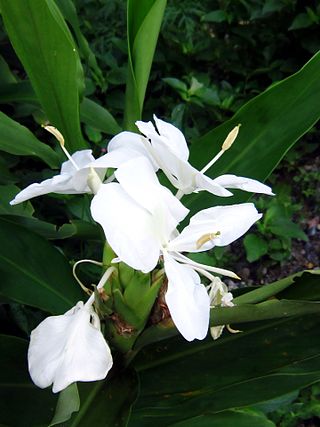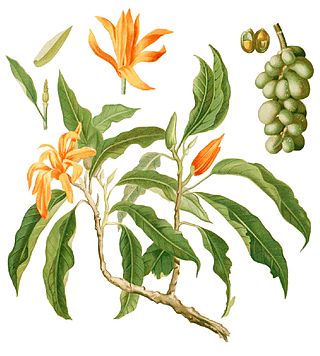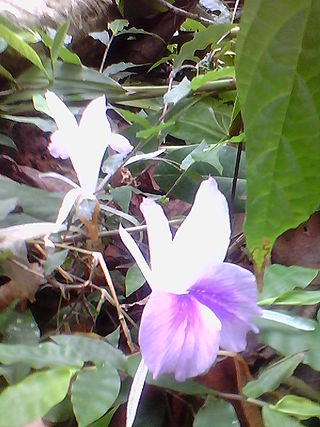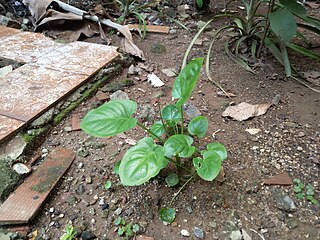
Boesenbergia rotunda, commonly known as Chinese keys, fingerroot, lesser galangal or Chinese ginger, is a medicinal and culinary herb from China and Southeast Asia. In English, the root has traditionally been called fingerroot, because the shape of the rhizome resembles that of fingers growing out of a center piece.

Myoga, myoga ginger or Japanese ginger is the species Zingiber mioga in the family Zingiberaceae. It is a deciduous herbaceous perennial native to Japan, China, and the southern part of Korea. Only its edible flower buds and flavorful shoots are used in cooking. The flower buds are finely shredded and used in Japanese cuisine as a garnish for miso soup, sunomono, and dishes such as roasted eggplant. In Korean cuisine, the flower buds are skewered alternately with pieces of meat and then are pan-fried.

Acampe, abbreviated as Acp in horticultural trade, is a genus of monopodial, epiphytic vandaceous species of orchids, distributed from tropical Asia from India, eastwards to China and southwards to Malaysia, and the Philippines as well as from tropical Africa, Madagascar and islands of the Indian Ocean. The name Acampe was derived from the Greek word akampas, meaning "rigid", referring to the small, brittle, inflexible flowers.

Amomum is a genus of plants native to China, the Indian subcontinent, Southeast Asia, New Guinea, and Queensland. It includes several species of cardamom, especially black cardamom. Plants of this genus are remarkable for their pungency and aromatic properties.

Hedychium is a genus of flowering plants in the ginger family Zingiberaceae, native to lightly wooded habitats in Asia. There are approximately 70-80 known species, native to India, Southeast Asia, and Madagascar. Some species have become widely naturalized in other lands, and considered invasive in some places.

Guzmania is a genus of over 120 species of flowering plants in the botanical family Bromeliaceae, subfamily Tillandsioideae. They are mainly stemless, evergreen, epiphytic perennials native to Florida, the West Indies, southern Mexico, Central America, and northern and western South America. They are found at altitudes of up to 3,500 m (11,483 ft) in the Andean rainforests.

Hedychium coronarium, the white garland-lily or white ginger lily, is a perennial flowering plant in the ginger family Zingiberaceae, native to the forest understorey of Asia.

Hedychium flavescens is a perennial flowering plant from the Zingiberaceae. It is native to the Himalayas, Sichuan, and northern Vietnam, and naturalized in various other lands.

Hedychium gardnerianum, the Kahili ginger, Kahila garland-lily or ginger lily, is a species of flowering plant in the ginger family Zingiberaceae, native to the Himalayas in India, Nepal, and Bhutan. It is an erect herbaceous perennial growing to 8 ft (2.4 m) tall with long, bright green leaves clasping the tall stems. The very fragrant pale yellow and red flowers are held in dense spikes above the foliage. They appear towards the end of summer.

Magnolia champaca, known in English as champak, is a large evergreen tree in the family Magnoliaceae. It was previously classified as Michelia champaca. It is known for its fragrant flowers, and its timber used in woodworking.

Hedychium spicatum is a plant species native to China, the Himalayas, Myanmar, Thailand and Ethiopia.

Ocimum americanum, known as American basil, lime basil, or hoary basil, is a species of annual herb in the family Lamiaceae. Despite the misleading name, it is native to Africa, the Indian Subcontinent, China, and Southeast Asia. The species is naturalized in Queensland, Christmas Island, and parts of tropical America.

Rhaphidophora decursiva is a species of flowering plant in the family Araceae. It is native to China, the Indian Subcontinent, and Indochina.

Dendrobium moschatum, the musky-smelling dendrobium, is a species of orchid. It is native to the Himalayas, and Indochina.

Cautleya is a small genus of perennial plants of the family Zingiberaceae, found in the eastern Himalayas through to China and Vietnam. It consists of two species of high-altitude tropical and temperate plants, native to cool forest areas – an unusual habitat for members of the Zingiberaceae. They are grown as ornamental flowering plants.

Kaempferia rotunda is a plant species in the ginger family. It is native to China, the Indian subcontinent, Indochina, and widely cultivated elsewhere. It is reportedly naturalized in Java, Malaysia and Costa Rica.

Cynomorium is a genus of parasitic perennial flowering plants in the family Cynomoriaceae. The genus consists of only one species, Cynomorium coccineum. Its placement in the Saxifragales was resolved in 2016 with the help of nuclear, plastid, and mitochondrial sequences obtained from next-generation sequencing. Common names include the misleading Maltese fungus or Maltese mushroom; also desert thumb, red thumb, tarthuth (Bedouin) and suoyang (Chinese). A rare or local species, it grows in dry, rocky or sandy soils, often in salt marshes or other saline habitats close to the coast. It has had a wide variety of uses in European, Arabian and Chinese herbal medicine.

Typhonium flagelliforme is a species of flowering plant in the family Araceae.
Caulokaempferia is a group of plants in the ginger family described as a genus in 1964. The genus is native to China, the Himalayas, and Indochina.
Stahlianthus is a genus of plants in the ginger family. It is native to southern China, the Himalayas, and Indochina.


















